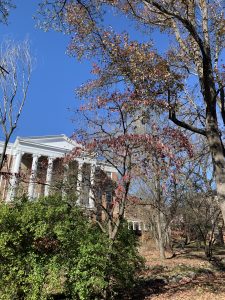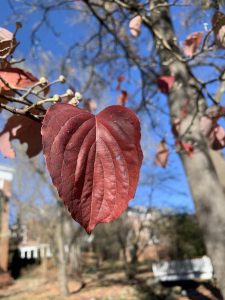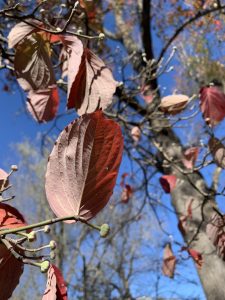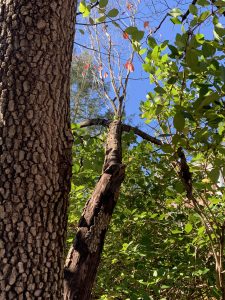
Flowering Dogwood
I arrived at my sit-spot at 12:45pm and stay until 1:20pm on November 18, and the temperature was a brisk 46 degrees Fahrenheit. The wind was blowing slightly but just enough to make the temperature seem to be a few degrees cooler. The sun was shining bright with no cloud cover, but the angel of the sun was behind one of the trees I was sitting near to the west putting me be in the shade. I was walking around trying to find something to identify that wasn’t so dead and brown, and that’s when the pink/red leaves caught my attention. The leaves were about the same color as the bush I was observing during each of my sit-spot sessions. Those were the only leaves in the Beale Garden that looked almost full of live, even though they were dying because of the season change. I was able to identify this tree as the Flowering Dogwood, also known as the Cornus florida.

pretty leaf color
The leaves on the tree was slightly longer than my palm, but not wider. The leaves almost appeared to have a droop like shape, but they are not droopy like the weeping willow, it is just the way the leaves are shaped on the steam I believe. The. upper side of the leaf was a dark pink/red and the underside was a light to pale pink. The leave did not have a waxy feel, it instead had sort of a papery feel on both sides. One may even lead to saying almost fuzzy feeling without the fuzz. There were buds all over the tree coming off the stems close to the leaves or where the leaves would have been before falling off. The leaves appeared to have some sort of lobed shaped, but it did not look like it was natural. The lobes almost seemed to look like the leaves shriveling up because they are dying in the early winter air.

You can see the sprouts and the underside of leaf here
The flowering dogwood is native to Eastern North American and northern Mexico. In the scientific nameCornus it means horn which is a reference ti the wood strength which was used in earlier times for making skewers. The southeastern native American tribes thought that this tree was a symbol of protection. They also used the bark and roots as dyes and medicines for headaches, fatigue, and fevers. The sap of this tree is extremely toxic, and as a result the native Americans used it as warfare (South Carolina Forestry Commission). The dogwood grows in a well-drained and lightly upland soil. It also can grow in deep moist soils along streams and lower slopes. The leaves are simple and oppositely arranges with a 4” to 6” long by 2” to 3” wide leaf. The flowers are small and have four big white and sometimes pink petal like bracts. The fruits are ½” long and they are glossy bright red with an ellipsoid drupe. These trees are fast growing and small mammals, squirrels, and raccoons are attracted to the fruit in autumn(SFRC : 4-H).

Bark, and it looks like something may have eaten the bark on this branch here
In order to identify this tree, I simply searched “trees with round looking buds and red leaves” on google and the first thing that popped was the flowering dogwood that looked exactly like the picture/tree that I saw at my sit-spot. The process of identifying species is so fascinating to me. I feel like I am a scientist making a new discovery when I am able to identify what species I find. I really enjoy going out into nature and discovering new species so when I am out with friends or family, I can name off the different type of species and they will think I am intelligent.
South Carolina Forestry Commission. Flowering Dogwood. http://www.trees.sc.gov/pubs/floweringdogwood.pdf.
SFRC : 4-H : Flowering dogwood. http://sfrc.ufl.edu/extension/4h/trees/flowering_dogwood/index.html.

Leave A Comment
You must be logged in to post a comment.